Four National Guard biplanes buzzed over the State Capitol in St. Paul on Sept. 9, 1919, to salute President Woodrow Wilson, who was in the Twin Cities to drum up support for the League of Nations.
Through a classroom window at nearby Mechanic Arts High School, 16-year-old Phoebe Fairgrave gazed skyward at the planes.
"I hadn't given a thought to aviation until that day, but suddenly, as I watched those planes, I wanted to fly," she told a magazine writer a decade later.
Less than two years later, thousands of spectators squinted upward from the Curtiss Northwest Airport at Snelling and Larpenteur avenues, near the Minnesota State Fairgrounds. Diminutive at 5 feet tall and just under 100 pounds, 18-year-old Phoebe climbed out on the wing of a Curtiss Oriole biplane 3 miles up — intent on eclipsing Chicagoan Mabel Cody's 11,000-foot woman's world record parachute plunge set in 1920.
Fairgrave wore basketball shoes with suction cups, an aviator's cap, goggles and an inner tube around her middle — just in case she landed in a lake. Never mind that the young daredevil wing-walker would soon dazzle crowds by dancing the Charleston on airplane wings, moving from plane to plane in midair and hanging by her teeth thousands of feet above crowds: She didn't know how to swim.
Although temperatures sizzled near 100 degrees that July day in 1921, Phoebe said she "could hardly fasten on my chute" in the high-altitude chill as she prepared to jump from 15,200 feet. Newspapers told how she fell from "a frigid Alaskan atmosphere of 10 degrees below zero back to the torture temperature of 98 degrees in the shade, all in 20 minutes."
She jumped over north Minneapolis and landed in a field not far from New Brighton. Her pilot, World War I aviator Vernon Omlie, circled above her as she descended, leading motorists to her landing spot. They welcomed her back to earth and drove her home.
According to next day's Minnesota Daily Star, Fairgrave spoke like a quintessential Minnesotan after her touchdown. She talked about the weather.
"'My, but it's hot!' were the plucky little jumper's first words when she landed,'" the newspaper reported.
Fairgrave would go on to become the first woman in the United States to be licensed as a transport pilot and aviation mechanic, the first to serve as a federal aviation executive and the first to fly a light plane over the Rocky Mountains.
She befriended famed fellow flyer Amelia Earhart as well as Eleanor and Franklin Roosevelt, and flew speakers around the country to support FDR's presidential runs in 1932 and 1936. She was in the first class of inductees for the Minnesota Aviation Hall of Fame in 1988, and was inducted 20 years later into the Tennessee Aviation Hall of Fame.
I wish I could report that Phoebe Fairgrave Omlie's story ended as happily as it began. Her final days were dark.
"She had spent her last years in an alcoholic haze in a seedy Indianapolis flophouse, in utter seclusion, refusing to see anyone for any reason, and suffering from lung cancer," according to a 2002 article in Aviation History magazine.
Phoebe was born in Des Moines on Nov. 21, 1902, the same year as Charles Lindbergh and a year before the Wright brothers' first flight in Kitty Hawk, N.C. When she was 12 she moved with her mother Madge to St. Paul, where her stepfather, Andrew Fairgrave, operated a downtown saloon in the years before before Prohibition. The 1920 federal census lists him as a soft-drink merchant the year after booze was banned.
Seven months after her historic jump, she married pilot Omlie at her home in St. Paul. By 1925, the couple had given up barnstorming stunt shows and moved to Memphis, where they built the first commercial airport in the region for their airline, Mid-South Airways. Omlie died in a plane crash in August 1936, as a passenger on a commercial airliner that failed to navigate fog while landing in St. Louis.
All told, Phoebe spent only 11 of her 72 years in Minnesota. Despite that limited window of time, she continued to refer to St. Paul as her home for years, according to a definitive profile by Roger Bergerson in the Spring 2013 issue of Ramsey County History. That story, chock-full of photos, can be found at tinyurl.com/PhoebeFairgrave.
Phoebe died on July 17, 1975, in Indianapolis. A lifelong smoker, her death certificate puts lung cancer as the cause of death and lists her as a retired aviator. She was buried next to her husband in Memphis, where the air traffic control tower at the nearby international airport was named in their honor in 1982 — a tribute neither of them lived long enough to see.
Curt Brown's tales about Minnesota's history appear every other Sunday. Readers can send him ideas and suggestions at mnhistory@startribune.com. His latest book looks at 1918 Minnesota, when flu, war and fires converged: strib.mn/MN1918.

Minnesota History: Ad man turned Paul Bunyan into a folklore icon

Minnesota History: James Griffin used persistence to blaze a trail for St. Paul's Black police officers

Minnesota History: For Granite Falls doctor who tested thousands of kids for TB, new recognition is long overdue

Minnesota History: A New Ulm baker wearing a blanket fell to friendly fire in the U.S.-Dakota War



